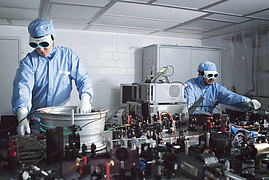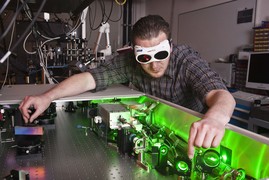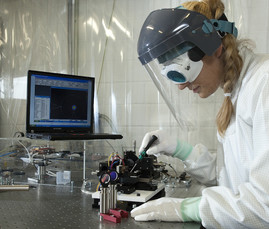Posted on Youtube.com
List of Research Groups
- Ultrahigh Quality Optical Layers and Characterisation
- 3rd Generation Gravitational Wave Detector Laser Source
- Fiber Optics
- Sub-Hz Lasers and High-Performance Cavities
- Photonic Devices for Space Applications
- Mode-locked Lasers / Mode Combs
- Nanophotonics
Overview
Optical technologies have a long tradition in Hanover, given an official footing as long ago as 1986 with the foundation of the Laser Zentrum Hannover e.V.. Over the past 20 years, unique qualifications have been established, especially in laser-, thin-film, and space technologies, which are now amongst the essential foundations of QUEST.
A cornerstone of topical research in QUEST is the research area “Enabling Technologies”, where the technological foundation for the other three research areas is itself the subject of investigation. In the group “Ultra High Quality Optical Layers and Characterisation” new optical materials and thin film processes for laser components are developed. The Group “Nanophotonics” produces 2D and 3D micro-and nanostructures and analyzes their optical properties. Special integrated optical fiber components are produced and characterized with high precision in the group “Fiber Optics”. In the junior research group "3rd Generation Gravitational Wave Detector Laser Source “ new concepts for high power lasers for the observation of gravitational waves are explored. The research group “Sub-Hz Laser and High-Performance Cavities” investigates ultra narrow bandwidth lasers for precision metrology while the group “Mode Locked Laser / Mode Combs “ is working on mode-locked comb generators. Finally, in “Photonic Devices for Space Applications” space technologies are pursued.
Substantial strategic investments together with a new professorship for applied physics in QUEST strengthen the Hanover research location. Within this research area, combined with the Task Group “Advanced Light Sources and Optical Materials”, QUEST advances the collaboration network between the Leibniz Universität Hannover, the Max-Planck-Institute for Gravitational Physics (Albert-Einstein-Institut), the Laser Zentrum Hannover e.V., and the Physikalisch-Technische Bundesanstalt in Braunschweig. The resulting local competence center allows for ongoing global technology leadership.





 ©
T.Damm/QUEST
©
T.Damm/QUEST







